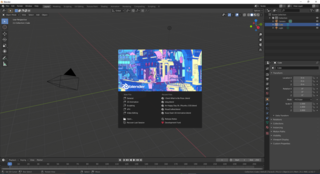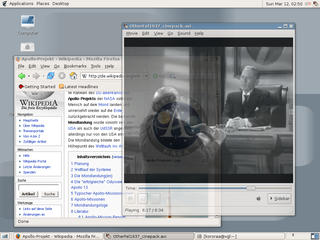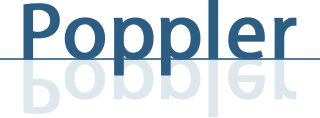
Rendering or image synthesis is the automatic process of generating a photorealistic or non-photorealistic image from a 2D or 3D model by means of computer programs. Also, the results of displaying such a model can be called a render. A scene file contains objects in a strictly defined language or data structure; it would contain geometry, viewpoint, texture, lighting, and shading information as a description of the virtual scene. The data contained in the scene file is then passed to a rendering program to be processed and output to a digital image or raster graphics image file. The term "rendering" may be by analogy with an "artist's rendering" of a scene.

Konqueror is a free and open-source web browser and file manager that provides web access and file-viewer functionality for file systems. It forms a core part of the KDE Software Compilation. Developed by volunteers, Konqueror can run on most Unix-like operating systems. The KDE community licenses and distributes Konqueror under the GNU General Public License version 2.

Blender is a free and open-source 3D computer graphics software toolset used for creating animated films, visual effects, art, 3D printed models, motion graphics, interactive 3D applications, and computer games. Blender's features include 3D modeling, UV unwrapping, texturing, raster graphics editing, rigging and skinning, fluid and smoke simulation, particle simulation, soft body simulation, sculpting, animating, match moving, rendering, motion graphics, video editing, and compositing.

Pango is a text layout engine library which works with the HarfBuzz shaping engine for displaying multi-language text.
GLX is an extension to the X Window System core protocol providing an interface between OpenGL and the X Window System as well as extensions to OpenGL itself. It enables programs wishing to use OpenGL to do so within a window provided by the X Window System. GLX distinguishes two "states": indirect state and direct state.

WebKit is a browser engine developed by Apple and primarily used in its Safari web browser, as well as all the iOS web browsers. WebKit is also used by the BlackBerry Browser, the Tizen mobile operating systems, and a browser included with the Amazon Kindle e-book reader. WebKit's C++ application programming interface (API) provides a set of classes to display Web content in windows, and implements browser features such as following links when clicked by the user, managing a back-forward list, and managing a history of pages recently visited.

In scientific visualization and computer graphics, volume rendering is a set of techniques used to display a 2D projection of a 3D discretely sampled data set, typically a 3D scalar field.
PHIGS is an application programming interface (API) standard for rendering 3D computer graphics, considered to be the 3D graphics standard for the 1980s through the early 1990s. Subsequently, a combination of features and power led to the rise of OpenGL, which became the most popular professional 3D API of the mid to late 1990s.
Cairo is an open source programming library that provides a vector graphics-based, device-independent API for software developers. It provides primitives for two-dimensional drawing across a number of different back ends. Cairo uses hardware acceleration when available.

Xgl is an obsolete display server implementation supporting the X Window System protocol designed to take advantage of modern graphics cards via their OpenGL drivers, layered on top of OpenGL. It supports hardware acceleration of all X, OpenGL and XVideo applications and graphical effects by a compositing window manager such as Compiz or Beryl. The project was started by David Reveman of Novell and first released on January 2, 2006. It was removed from the X.org server in favor of AIGLX on June 12, 2008.
Windows Presentation Foundation (WPF) is a free and open-source graphical subsystem originally developed by Microsoft for rendering user interfaces in Windows-based applications. WPF, previously known as "Avalon", was initially released as part of .NET Framework 3.0 in 2006. WPF uses DirectX and attempts to provide a consistent programming model for building applications. It separates the user interface from business logic, and resembles similar XML-oriented object models, such as those implemented in XUL and SVG.

High-dynamic-range rendering, also known as high-dynamic-range lighting, is the rendering of computer graphics scenes by using lighting calculations done in high dynamic range (HDR). This allows preservation of details that may be lost due to limiting contrast ratios. Video games and computer-generated movies and special effects benefit from this as it creates more realistic scenes than with the more simplistic lighting models used.

Poppler is a free software utility library for rendering Portable Document Format (PDF) documents. Its development is supported by freedesktop.org. It is commonly used on Linux systems, and is used by the PDF viewers of the open source GNOME and KDE desktop environments.

QuteMol is an open-source, interactive, molecular visualization system. QuteMol utilizes the current capabilities of modern GPUs through OpenGL shaders to offer an array of innovative visual effects. QuteMol visualization techniques are aimed at improving clarity and an easier understanding of the 3D shape and structure of large molecules or complex proteins.

EGL is an interface between Khronos rendering APIs and the underlying native platform windowing system. EGL handles graphics context management, surface/buffer binding, rendering synchronization, and enables "high-performance, accelerated, mixed-mode 2D and 3D rendering using other Khronos APIs." EGL is managed by the non-profit technology consortium Khronos Group.

Arion is a physically based, unbiased render engine developed by RandomControl.
Blink is a browser engine. It is developed as part of the Chromium project with contributions from Google, Facebook, Microsoft, Opera Software, Adobe Systems, Intel, IBM, Samsung, and others. It was first announced in April 2013.

Orx is an open-source, portable, lightweight, plug-in-based, data-driven and easy to use 2D-oriented game engine written in C.

Stride is a free and open-source 2D and 3D cross-platform game engine originally developed by Silicon Studio. It can be used to create video games for PC and mobile devices, and virtual reality.















